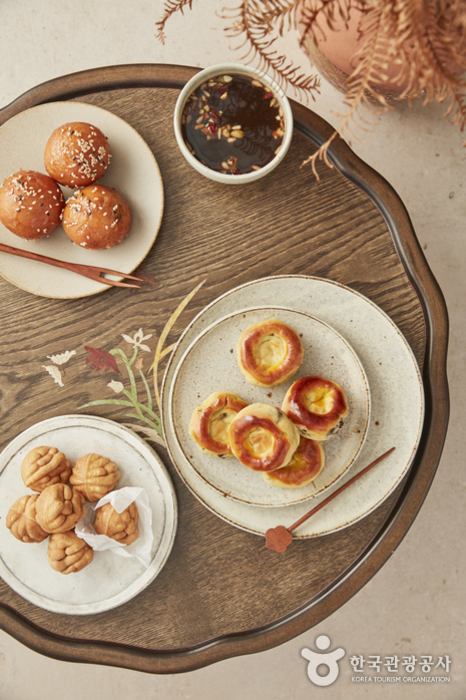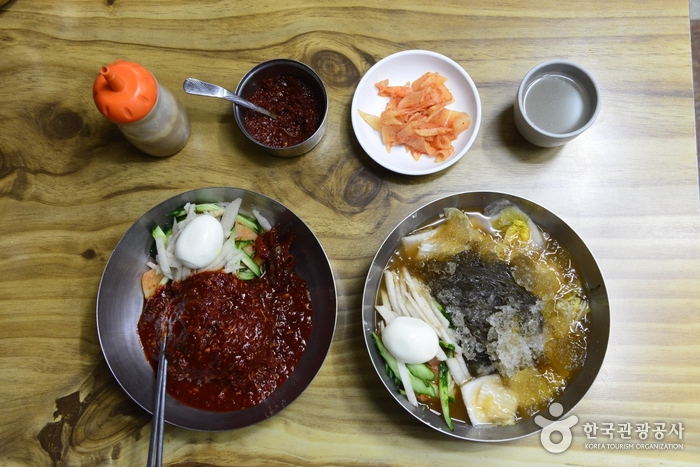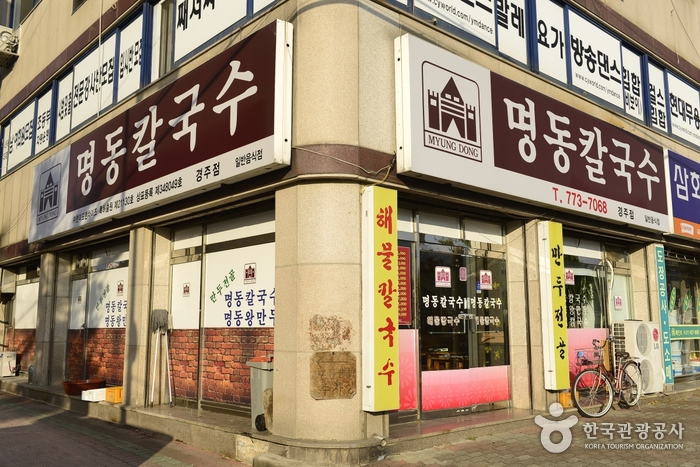Hwangnam Bread (황남빵)
6.9Km 2025-03-19
783, Taejong-ro, Gyeongju-si, Gyeongsangbuk-do
Pyeongyang Naengmyeon (평양냉면)
7.0Km 2025-05-19
10, Wonhyo-ro 105beon-gil, Gyeongju-si, Gyeongsangbuk-do
Áreas Históricas de Gyeongju (경주역사유적지구) [Patrimonio Cultural de la Humanidad de la Unesco]
7.1Km 2025-03-17
Taejong-ro 757, Gyeongju-si, Gyeongsangbuk-do.
Designado como Patrimonio Cultural de la Humanidad por la Unesco en noviembre del 2000, es una zona histórica que conserva toda la historia y cultura de Gyeongju, la antigua capital de Silla (57-935). Se clasifican en un total de 5 áreas históricas. La primera es la zona de Namsan, la cuna del arte budista de Silla. Considerado un museo al aire libre sin paredes, es un lugar en donde persiste el espíritu de Silla, y reúne 37 reliquias budistas; el pabellón Poseokjeong (Sitio Histórico), la roca Tapgok Maaejosanggun (Tesoro – figuras budistas grabadas en roca), la pagoda de tres pisos de piedra del templo Cheonryongsa (Tesoro), la roca Chilburam Maaeseokbul (Tesoro - figuras budistas grabadas en roca), la roca Bulgok Seokbuljwasang (Tesoro), etc. La segunda es la zona de Wolseong, sitio en donde estaban los palacios de la dinastía milenaria de Silla. Se encuentran en esta área el bosque Gyerim (Sitio Histórico), el sitio de la sala Imhaejeon, y el mejor observatorio de Asia, Cheomseongdae (Tesoro Nacional). La tercera es la zona de Daereungwon, el complejo de tumbas reales, los pertenecientes a los reyes, reinas y miembros de la nobleza. Durante su proceso de excavación se han encontrado coronas, pinturas de caballos míticos, variedad de cerámica, etc., entre otras reliquias que han servido como base de estudio histórico. La cuarta es la zona en donde se encontraba instalado el famoso templo Hwangnyongsa (Sitio Histórico). Y por último, la quinta zona, es el lugar en donde se establecía la fortaleza Myeonghwalsanseong (Sitio Histórico), que se presume que fue construido hace 400 años. Estas áreas históricas de Gyeongju, designadas como Patrimonio Cultural de la Humanidad por la Unesco, comprenden un total de 52 patrimonios culturales.
Bulguksa Hanok Dongodang (불국사한옥동오당)
7.1Km 2024-07-30
5-58 Jinti-gil, Gyeongju-si, Gyeongsangbuk-do
Gyeongjuhanok 1st [Korea Quality] / 경주 한옥 1번가 [한국관광 품질인증]
7.2Km 2021-04-05
20, Cheonwon 1-gil, Gyeongju-si, Gyeongsangbuk-do
010-9505-5367
As a new hanok guesthouse, Gyeongju Hanok 1st is located at the entrance to Cheonwon Village, Gyeongju, Gyeongsangbuk-do. It has various modern amenities while preserving the features of a traditional Korean house. The guesthouse is kept cool in summer and warm in winter, so guests can experience the traditional Korean house. It has various rooms in different sizes that can accommodate 3 - 8 people. There is a stand-alone guesthouse furnished with kitchen and bathroom as well. All other rooms also have a bathroom inside, but the kitchen must be shared among the guests. There are no beds in the room as is typical of a traditional Korean house, but there are high-quality sheets and blankets for the comfort of the guests. The guesthouse has a large front yard with a miniature traditional Korean house with dolls adorned in traditional clothes, not to mention other traditional artifacts. Popular tourist destinations within the vicinity of the guesthouse include Anapji Pond, Cheomseongdae, and Gyeongju National Museum.
Hanokinn [Korea Quality] / 한옥人(한옥인) [한국관광 품질인증/Korea Quality]
7.2Km 2023-04-13
19, Poseok-ro 1050beon-gil, Gyeongju-si, Gyeongsangbuk-do
This hanok (traditional Korean house) is located at the center of Hanok Conservation Area, known as Hwangnidan-gil Street. To the north lies the old alley that connects to Cheomseongdae Observatory. The house has sarangchae building, byeolchae building, and main building, which is used as a gallery and café, surrounding the grass lawn in the center. All rooms are equipped with ondol (under-the-heating system) and a red clay finish, and each room has a bathroom with shower facilities.
Sarangchae is a two-story hanok building with a hipped-and-gable roof. Its first floor is occupied by a double room and a family room, which can support up to 4 people. Byeolchae is a single-floor hanok with a gable roof, containing two double rooms and a raised floor space. The main building’s gallery contains a hanok experience room, cafe, restaurant, and a traditional tea room. A Korean-style breakfast is offered in the cafe, and the management also offers experience programs like tea ceremony, traditional games like yunnori (board game), and traditional musical instruments like janggo (hourglass-shaped drums) and gayageum (twelve-stringed zither).
Myeongdong Kalguksu (명동칼국수)
7.2Km 2020-06-12
46-4, Yongdam-ro, Gyeongju-si, Gyeongsangbuk-do
+82-54-773-7068
Myeongdong Kalguksu serves top-grade food made with the freshest ingredients. Visitors can try kalguksu and various mandu dishes in a cozy atmosphere.
Wadamjung [Korea Quality] / 와담정 [한국관광 품질인증]
7.2Km 2023-04-13
18, Cheonwon 1-gil, Gyeongju-si, Gyeongsangbuk-do
+82-54-772-5400 / +82-10-6571-3412
Wadamjung in Cheonwon Village, Gyeongju is a modern traditional Korean guesthouse built in May 2017, with both the features of a traditional Korean house and modern facilities such as air conditioner and bathroom. It has a total of nine guestrooms that can accommodate three to six people, and there is a kitchen that can be shared among the guests. A large group can book a stand-alone guestroom that can accommodate up to 12 people, inclusive of a kitchen. There are various traditional artifacts and items with which to play a traditional game in the large yard, such as Jegi (Korean shuttlecock game) and Tuho (Arrow-throwing). In addition, there are a number of tourist destinations such as Cheomseongdae in Wolseong District, with lots of historical sites in Gyeongju as well as Gyeongju National Museum.
Gruta Seokguram de Gyeongju (경주 석굴암) [Patrimonio Cultural de la Humanidad de la Unesco]
7.2Km 2025-05-27
Seokgul-ro 238, Gyeongju-si, Gyeongsangbuk-do.
Seokguram, situado en el monte Tohamsan, es el templo de piedra representativo de Corea. El nombre oficial de Seokguram, un Tesoro Nacional, es Seokguram Seokgul. Designado como Emplazamiento de Patrimonio Cultural Mundial por la Unesco en 1995, es un templo artificial de piedra hecho de granito. La construcción comenzó con Kim Dae-seong (700-774) en el año 751, durante el reinado del rey Gyeong-deok (742-765) de la dinastía Silla (57 a.C.-935 d.C.) y se terminó veinticuatro años más tarde, en 774, durante el reinado del rey Hye-gong (765-780).
Seokguram es famoso por haber sido construido con el templo Bulguksa. Según el libro de historia Samgukyusa, de la dinastía Goryeo (el pueblo que unificó la Península Coreana a finales del período de Silla, 918-1392), Kim Dae-seong había construido Bulguksa para sus padres que estaban vivos, y Seokguram para los padres de su vida pasada.
Seokguram está hecho de granito, y está situado en el pico oriental del monte Tohamsan. Dentro de la sala principal, de forma redonda, están las estatuas de Bonjon Bodhisattva y sus discípulos. Seokguram se construyó para preservar estas estatuas. La figura de Bonjon, que luce una generosa sonrisa, está sentada en una plataforma esculpida con un diseño de flores de loto. El techo redondeado parece una media luna o un arco y sobre él tiene una cubierta decorada con flores de loto. Puesto que la salida del sol desde este lugar es muy hermosa, mucha gente sube a la montaña al amanecer.
Parque Hwangseong (황성공원)
7.2Km 2025-05-27
Yongdam-ro 79-41, Gyeongju-si, Gyeongsangbuk-do


![Áreas Históricas de Gyeongju (경주역사유적지구) [Patrimonio Cultural de la Humanidad de la Unesco]](http://tong.visitkorea.or.kr/cms/resource/03/2656603_image2_1.jpg)

![Gyeongjuhanok 1st [Korea Quality] / 경주 한옥 1번가 [한국관광 품질인증]](http://tong.visitkorea.or.kr/cms/resource/10/2530210_image2_1.jpg)
![Hanokinn [Korea Quality] / 한옥人(한옥인) [한국관광 품질인증/Korea Quality]](http://tong.visitkorea.or.kr/cms/resource/65/2707565_image2_1.jpg)

![Wadamjung [Korea Quality] / 와담정 [한국관광 품질인증]](http://tong.visitkorea.or.kr/cms/resource/35/2557635_image2_1.jpg)
 Español
Español
 한국어
한국어 English
English 日本語
日本語 中文(简体)
中文(简体) Deutsch
Deutsch Français
Français Русский
Русский